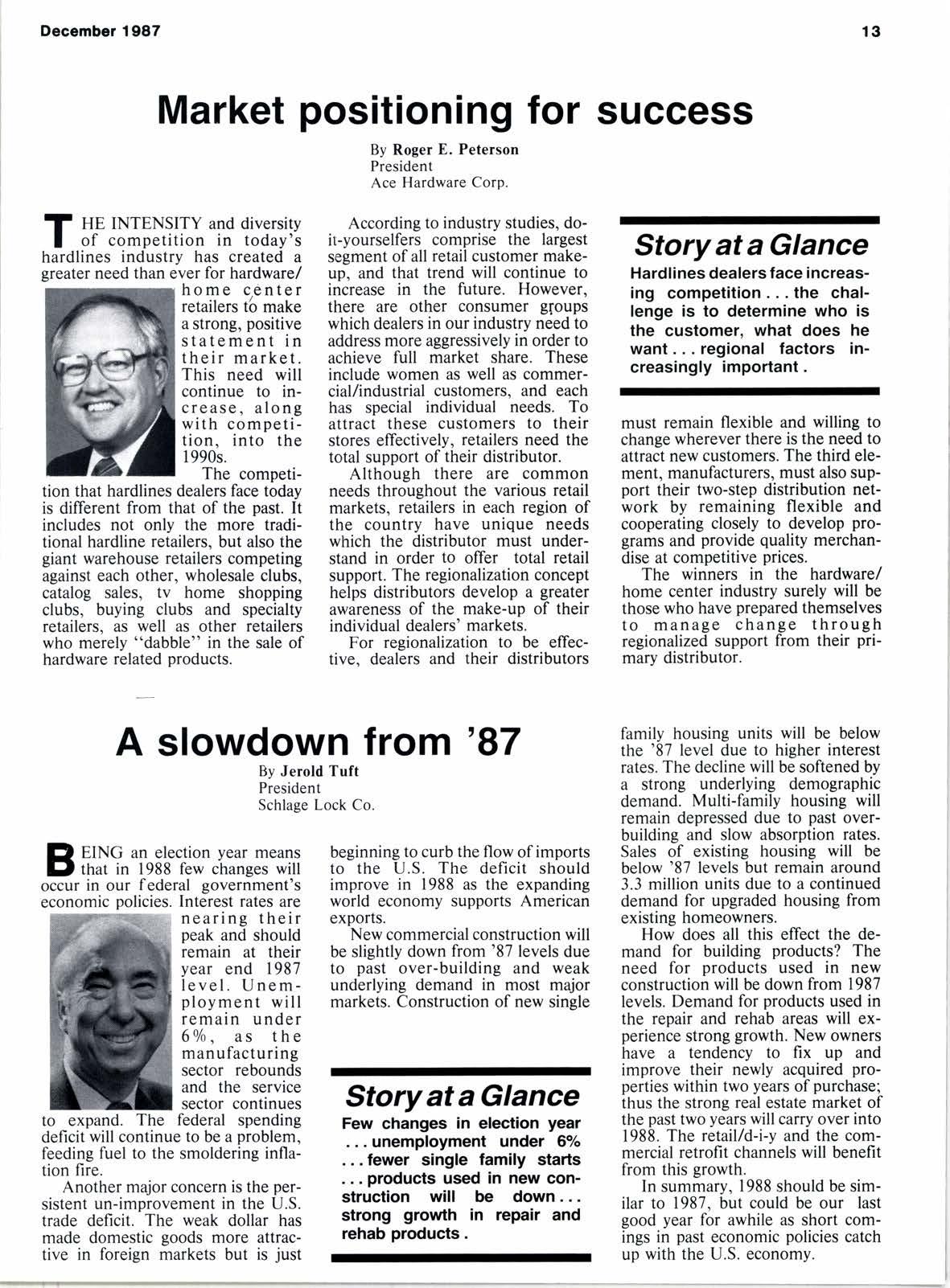
2 minute read
Market positioning for success
By Roger E. Peterson President Ace Hardware Corp.
T He INTENSITY and diversity
I of competition in today's hardlines industry has created a greater need than ever for hardware/ home
C6nter
retailers tb make a strong, positive statement in their market. This need will continue to increase, along with competi-tion, into the 1990s.
The competition that hardlines dealers face today is different from that of the past. It includes not only the more traditional hardline retailers, but also the giant warehouse retailers competing against each other, wholesale clubs, catalog sales, tv home shopping clubs, buying clubs and specialty retailers, as well as other retailers who merely "dabble" in the sale of hardware related products.
According to industry studies, doit-yourselfers comprise the largest segment of all retail customer makeup, and that trend will continue to increase in the future. However. there are other consumer gfoups which dealers in our industry need to address more aggressively in order to achieve full market share. These include women as well as commerciallindustrial customers, and each has special individual needs. To attract these customers to their stores effectively, retailers need the total support of their distributor.
Although there are common needs throughout the various retail markets, retailers in each region of the country have unique needs which the distributor must understand in order to offer total retail support. The regionalization concept helps distributors develop a greater awareness of the make-up of their individual dealers' markets.
For regionalization to be effective, dealers and their distributors
A slowdown from '87
By Jerold Tuft President Schlage Lock Co.
EING an election year means that in 1988 few changes will occur in our federal government's economic policies. Interest rates are remain at their year end 1987 level. Unemployment will remain under 60/0, as the manufacturing sector rebounds and the service sector continues to expand. The federal spending deficit will continue to be a problem, feeding fuel to the smoldering inflation fire.
Another major concern is the persistent un-improvement in the U.S. trade deficit. The weak dollar has made domestic goods more attractive in foreign markets but is just
Story at a Glance
Hardlines dealers face increasing competition...the challenge is to determine who is the customer, what does he want. . . regional factors increasingly important.
must remain flexible and willing to change wherever there is the need to attract new customers. The third element, manufacturers, must also support their two-step distribution network by remaining flexible and cooperating closely to develop programs and provide quality merchandise at competitive prices.
The winners in the hardware/ home center industry surely will be those who have prepared themselves to manage change through regionalized support from their primary distributor.
beginning to curb the flow of imports to the U.S. The deficit should improve in 1988 as the expanding world economy supports American exports.
New commercial construction will be slightly down from '87 levels due to past over-building and weak underlying demand in most major markets. Construction of new single
Story at a Glance
Few changes in election year unemployment under 67o fewer single family starts ... products used in new construction will be down. strong growth in repair and rehab products.
family housing units will be below the '87 level due to higher interest rates. The decline will be softened by a strong underlying demographic demand. Multi-family housing will remain depressed due to past overbuilding and slow absorption rates. Sales of existing housing will be below '87 levels but remain around 3.3 million units due to a continued demand for upgraded housing from existing homeowners.
How does all this eflect the demand for building products? The need for products used in new construction will be down from 1987 levels. Demand for products used in the repair and rehab areas will experience strong growth. New owners have a tendency to fix up and improve their newly acquired properties within two years of purchase; thus the strong real estate market of the past two years will carry over into 1988. The retail/d-i-y and the commercial retrofit channels will beneht from this growth.
In summary, 1988 should be similar to 1987, but could be our last good year for awhile as short comings in past economic policies catch up with the U.S. economy.









